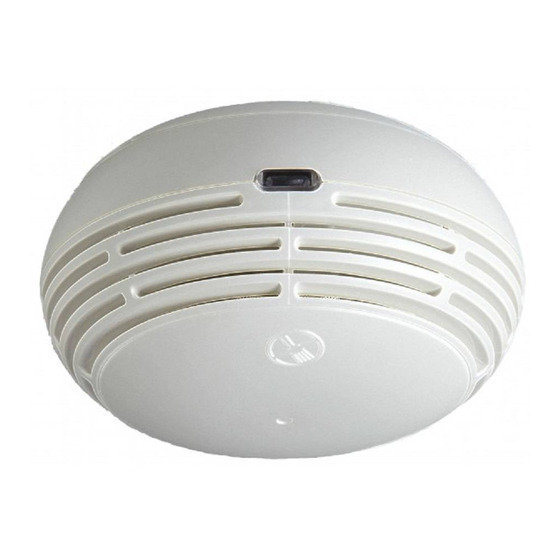
Table of Contents
Advertisement
Quick Links
Advertisement
Table of Contents

Summary of Contents for Finsecur CALYPSO-II
- Page 1 Datasheet CALYPSO‐II Smoke detector Smoke detector ...
- Page 2 RESENTATION Calypso‐II is a home smoke detector made on the basis of a professional detector. Conceived for individual houses and flats, Calypso‐II detects smokes coming from incipient fires and alerts you by a strong alarm signal. Please read the following pages to commission and install Calypso‐II. CAUTION: CALYPSO‐II does not detect heat, gaz or flames. Thank you for choosing this product. ENERAL CHARACTERISTICS supply: lithium battery (non replaceable) autonomy: 10 years smoke detection: by light diffusion sound power: 85dB at 9’ and 10’’ battery: light and sound signal in case of default battery test frequency: automatic, about every 50 seconds mounting: screws and rawplugs supplied for unperforated material protection against false alarm: • protection grid against insects • with algorithm handled by micro‐controller functional check: test button ...
- Page 3 NSTALLATION ADVICE Minimum installation One detector on each floor (in the corridor and stairs). Note: install detector(s) in priority in bedroom(s) access zone(s) because risks of smoke inhalation are more important while sleeping. Recommended installation One detector in each room. In rooms where false alarms can frequently occur (garage, kitchen…) see Implementation precaution. Avoid installing detectors in the bathroom. Examples minimal Flat House protection advice optimal protection implementation precaution To install a detector in the garage or the kitchen, please see Implementation precaution. ...
- Page 4 MPLEMENTATION PRECAUTION Disturbing phenomena • Condensation (laundry). • Water vapour in bathroom. Installing a detector in this room is banned because of the high risk of false alarms. • Smoke dilution in ventilated systems (air conditioning, heater, windows, others,etc). • Dust in attics, roofs, workshops, others,etc. • Abnormally low (‐0°C) or high (+55°C) room temperature. • Device generating smoke (cooktop, oven, car exhaust fumes, etc). Be sure of the room ventilation. • Car exhaust fumes (in garages): high risk of false alarms. Kitchen implementation We don’t advice you to install a detector in a kitchen because of the high risk of false alarms and of a rapid clogging of the detector. ...
- Page 5 Anti-theft device The integrated anti‐theft device is made to avoid thefts (in group housing for ex). Break the 2 nicks (see location below), the detector can be locked and blocked. If needed, you can activate the lever of the mechanical lock situated through the opening on the base (see below). Commissioning the battery You can use the tab to disconnect the internal battery. 1. Remove the tab by pulling it (towards you). After 20 seconds, the detector is commissioned (see below on the left). 2. Put the key away in the location space provided (see below on the right). At the end‐of‐life of the detector, you can disconnect the battery using the tab to stop the default sound signal and avoid any electric risk when recycling (see Closure of the detector). Mounting the detector 1. Present the detector on its base. 2. Turn clockwise until it’s locked. If the test button isn’t adjusted towards the entrance of the room, you can unlock it (anti‐clockwise) to make it do half a spin. 3. Push the test button to check its functionning. Smoke detector ...
- Page 6 EUTRALIZATION DEVICE The detector is equipped with a feature allowing the neutralization of the alarm signal when ⎯ the origin of the smoke has been identified, ⎯ there is a possible presence of smoke (in preventive). Examples: smoke coming from a toaster, a fryer, a cigarette or an activity in a workshop. The neutralization is automatically disactivated after 10 minutes. The detector comes back to its normal functionning. This allows you to ventilate the room without hearing the alarm signal and stopping each alarm on each detector. 1 ‐ Presence of smoke: 2 ‐ Press the test Neutralization in 1 red flash every 1 sec + button, the alarm signal presence of alarm signal. stops as well as the 3 ‐ Neutralization is smoke paired detectors. activated for 10 1 ‐ Before the presence 2 ‐ Press the test button Neutralization minutes: 1 ref flash of smoke: detector in for 2 sec. every 7 sec (if presence before the standby position + 1 After the test sound of smoke: 1 flash every 2 ...
- Page 7 ID ASSISTANCE Identification of sound signals Sound signals Interpretation 5 short and rapid beeps Powering 1 short beep/ 1 sec Level of detected smoke is reaching the level of alarm signal 2 successive short beeps Acknowledgement of an event (exit of the neutralization mode) 3 successive short beeps Acknowledgement of an event (activation of the neutralization mode) Identification of light signals Light signals Interpretation 1 red flash/ 1 sec Detector in alarm (local or from a paired detector) 1 red flash/ 7 sec Activation of the neutralization device 1 red flash/ 50 sec Normal functionning Identification of light and sound signals 1 red flash + 1 long beep/ 50 sec > battery default (main power supply, see instructions above). With the test button We recommended to test the functionning of the detector once a week. ...
- Page 8 HAT TO DO IN CASE OF FIRE As soon as the fire is detected, keep calm. Evacuate the area as rapidly as possible. If not possible, find a safe place with no smoke and lie on the floor to breathe. Call 112. ERTIFICATIONS CE marking The CE marking affixed on this product attests that it is in conformity with the essential requirements of the applicable directives, in particular its compliance to the harmonised specifications of NF EN 14604 standard, with regards to the 89/106/CEE directive relative to construction products. ...

Need help?
Do you have a question about the CALYPSO-II and is the answer not in the manual?
Questions and answers